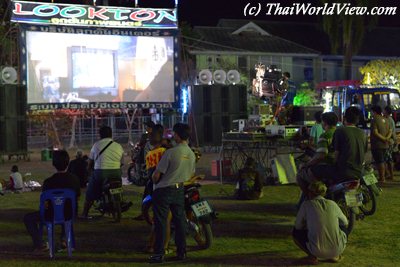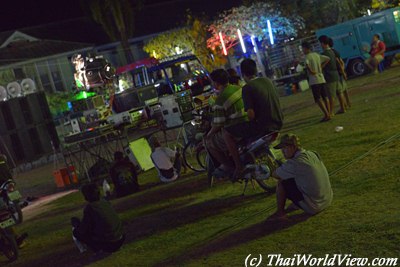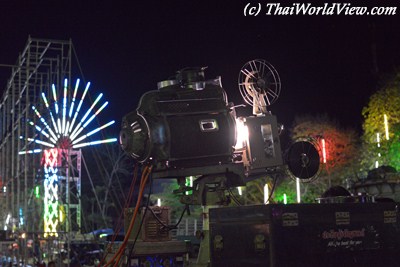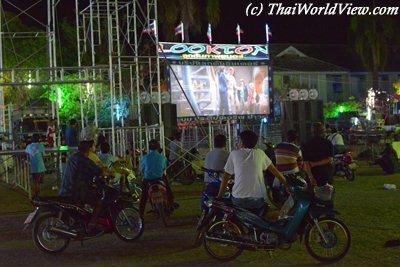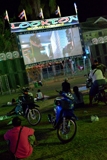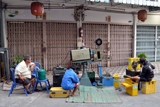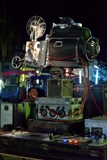THAI CINEMA HISTORY
Increase or decrease font size for easier reading : A+ A-
There were three kinds of open-air cinema in Thailand:
- "NANG KAI YA" (หนังขายยา) was used as promotional items by herbal-medicine salesmen at temple gatherings. Those movies were called "movies to sell medicine".
- "NANG LOM PHA" (หนังล้อมผ้า) was shown during feasts. A fence surrounded the screen so that a fee could be collected at the entrance.
- "NANG KLANG PLAENG" (หนังกลางแปลง) was shown in open-air during specific events (funeral, ordination...). There was no fee as a sponsor paid the whole fee.
- MOVIES TO SELL MEDICINE

Outdoor movies were more popular than "LIKAY" (ลิเก) or music concert as it cost less money to hire them and they could play movies the whole night.
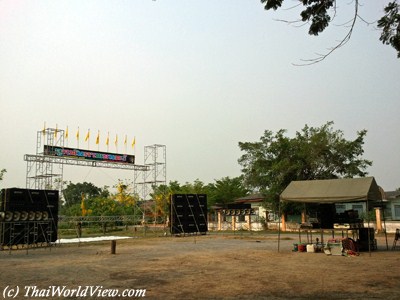
Villagers didn't have choice as sometimes the nearest doctor or nearest city was too far. They didn't want to lose a whole day going to the city. The medicine was sold when the projectionist was changing the movie reels.

Movies to sell medicine (หนังขายยา) concept was a way for business companies in Bangkok to reach people in villages. The movies were just to attract them. Products were not only medicine but also other products difficult to find in remote areas such a special soap, perfume...
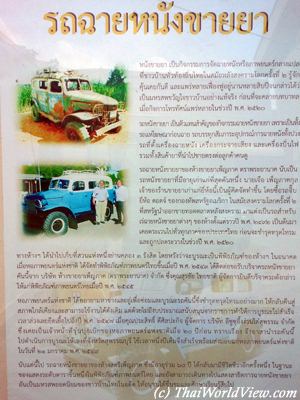
Thai movie "Baan Nong Ma Wo" (หนองหมาว้อ) (1979) shows this open-air cinema atmosphere very accurately such as young people (หนุ่มสาวจีบกัน) meeting secretly behind the screen...

In villages, a documentary was shown to local people to teach them things about personal hygiene. There was often a movie projected also to entice people to come. The movie was shown in the premises of Health Centres (ศูนย์เยาวชน).
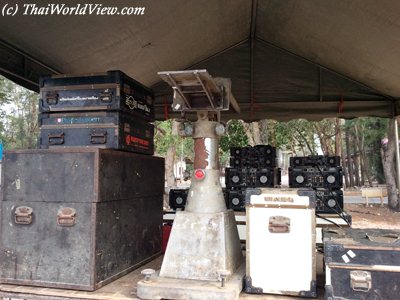
After World War II, Thai movie industry used 16mm format as 35mm reels were rare and expensive. There is no track for sound on 16mm reel.
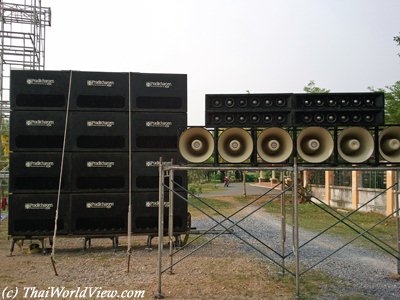
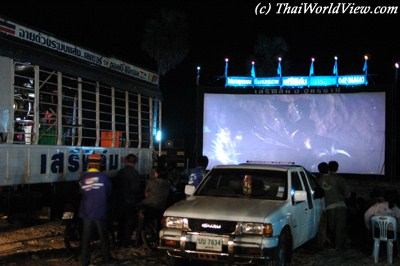
Companies selling medicine went progressively out of business due to various reasons, i.e. difficulties to get authorisation renewal approval, community Health Centre (สถานีสุขภาพ) being built in many villages and answering to direct health needs of villagers, cost of moving from 16mm to 35mm, people having TV at home so the movie appeal was reduced.

Viewers were charged five or ten baht. The revenue was split between distribution companies and the projectionist.
- DUBBERS

Sound effects and dialogue were provided live by the projectionist. They were filled with whatever regional references and such humour seemed to work best with the crowd. The prints were screened and rescreened until they became scratched beyond repair.

1) A single dubber but it is very tiring as the dubber needs to do all roles
2) A team but there is need for good synchronization (พากย์สด)
One of the most famous dubber remains Juree Osiri (จุรี โอศิริ). She was the voice of all leading actresses such as Petchara Chaowarat, Pissamai Wilaisak, Pawana Chanajit, Naowarat Yooktanun and Lalana Sulawan. She dubbed around 100 to 200 movies thanks to her sweet voice.
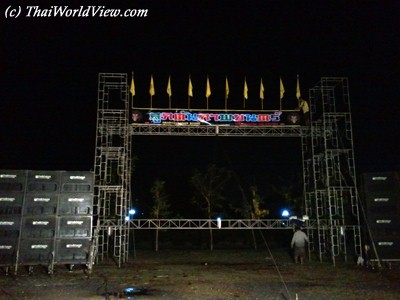
In decade 1970s Thai actors were still employed to dub live over foreign language movies screened in cinemas as it was cheaper than recording a whole new soundtrack. Sitting in a tiny booth, one or more actors read scripts and were altering their voices to mimic different characters. Later on some dubbing performances were recorded and used for other projections (จะมีเทปเสียงพากย์ติดมาด้วยครับ). Dubbing activies often happened four times a day (noon, 2PM, afternoon and evening). On Sunday, there was a morning session also.

Many Thai movies in 1960s were recorded at the same time and there were really only five or six key stars who appeared in all of them. They made so many films at once that the stars could never change their hairstyle. They always had to look the same. So when the prints started to wear out, the dubbers would mix together reels from several films and make up a new story in the dialogue. Nobody knew the difference!

In the past the movie dubber was a star and his name was often displayed in bigger fonts than the movie title itself! The dubber used instruments such as paper or spoon to make additional noise.
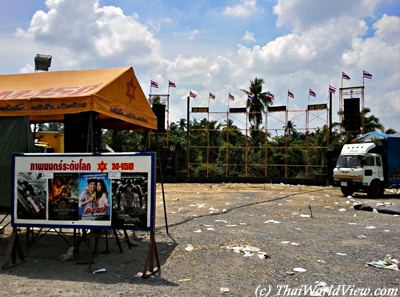
The difficulty in dubbing with old movies is that part of the film may be missing but the text is complete!
- OPEN-AIR CINEMA
Outdoor movies are still used for ceremonies such as monk robes offering ("THOT KATIN" - ทอดกฐิน), "new house" ceremony (ขึ้นบ้านใหม), temple fair (งานวัด), Chinese shrine celebration (งานศาลเจ้า) or various companies celebrations.

In the past, there was no TV at home. Some shops had TV but customers had to buy goods from the shop in order to be able to watch TV programs as the shop owner had to pay for TV electricity bill.

Projection of an outdoor movie can cost from 3 000 baht to 15 000 baht for a recent movie. Business is tough as nowadays people have already seen movies at theaters or at home on DVD so they will not go to see an outdated outdoor movie.
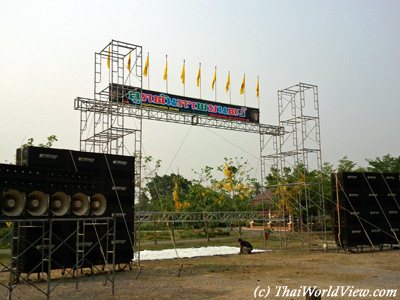
So less people watch outdoor movies. Digital revolution is also coming for projection. So getting film reels is becoming more and more difficult.
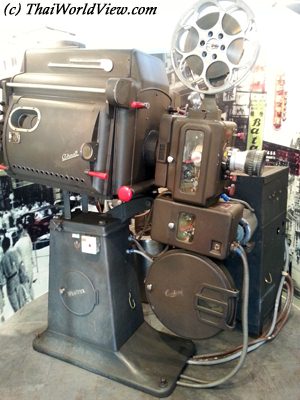
Some popular movies were shown and shown until they become unpopular and then moved to be shown in other provinces.
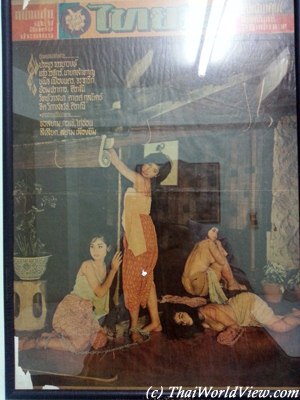
There are still around 1000 small companies in Thailand showing outdoor movies. The main difficulty of the business is the cost to rent movies due to high copyrights.
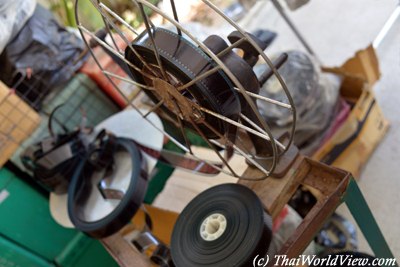
During outdoor cinema sessions, a few short movies (sports, news, cartoons) were shown before the main movie. Sometimes a small movie or a remaining left extract of another movie (ฟิล์มหัวม้วน) was placed at the beginning of the reel in order to preserve the main movie (around three minutes).
- DEITY FESTIVAL
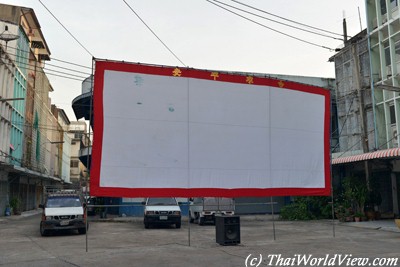
Outdoor cinema has less space in current business model for cinema. DVDs are coming out a few weeks after a movie release in theaters. So the movies shown in outdoor cinemas are no longer new, so people are less interested to watch.
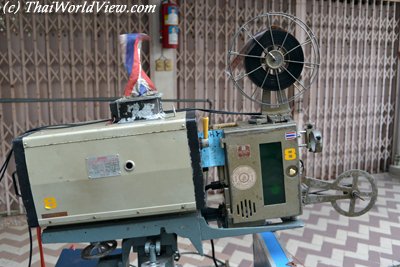
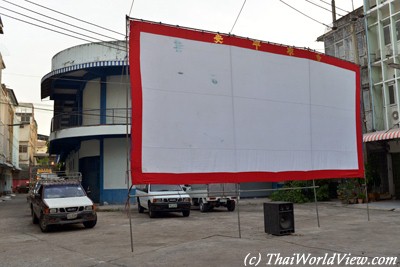
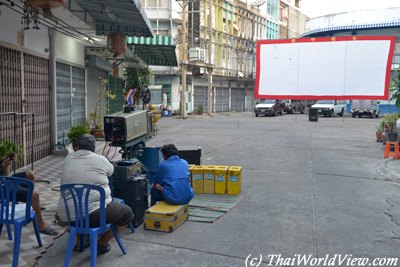
- SONGKRAN FAIR
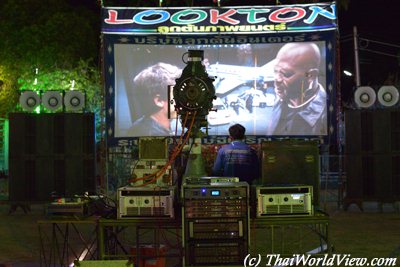
Nowadays it is difficult to find old projectors for open-air cinemas. Many projectionists use recycled pieces from other machines. Nowadays only 35mm projectors remain. 16mm projectors would scratch out and break films. Normally each movie is using a few film reels.
